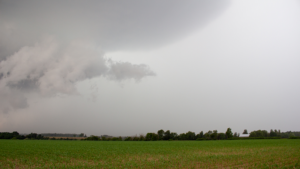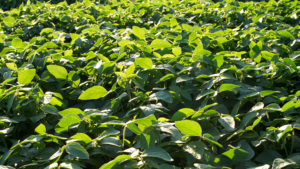Field observations
SPRING 2023
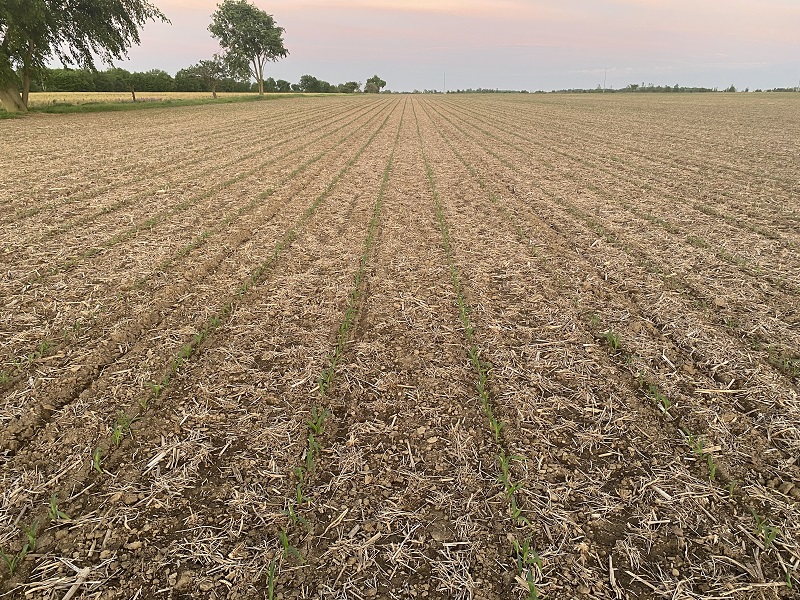
June 15, 2023
The rain gauge was arguably the least used piece of equipment on the farm this spring. That is until the start of this week when a very welcomed (gentle) rain was received across most of the province. Rain amounts varied, but any at this time of the season is welcome.
Corn
Finally, a drink of water allowed the corn plants to really take off. Corn is staging anywhere from V4 to V6 (5 to 7 leaves).
In last week’s crop updates, it was discussed that phosphorus (P) deficiencies were being seen due to a lack of moisture and cool soils; these will hopefully be mitigated with increased root growth from the rain and warming up of soil temperature as we get further into the spring season, to be able to reach more P reserves in the soil. P uptake, for optimum plant growth, throughout the season is fairly constant. Overall, once corn has emerged and developed two fully expanded leaves and a primary root, the plant needs nutrients supplied from the soil, as seed reserves are exhausted by this point. Banding fertilizer certainly helps with P availability, but there have been some concerns with slow nodal root development this year. As a rule, corn plant roots do not reach the middle of the rows until there are eight fully formed leaves, and corn is approximately knee high (hopefully by the 1st of July), where uptake from broadcast fertilizer will begin.
Tracey Baute, OMAFRA field crop entomologist, is looking for corn rootworm trap participants in Ontario. Those with continuous corn and a history of repeated use of Bt-CRW hybrids are encouraged to participate. Fields that were corn last year and may be in other crops this year can also be scouted for emerging beetle populations. If you are interested in participating in the network and need traps and protocols, please contact Tracey (tracey.baute@ontario.ca) so traps can be sent out before trapping starts at corn pollination timing.
Corn Rootworm Trap Network objectives:
1. increase scouting efforts in continuous corn fields;
2. understand changes in adult rootworm populations between years;
3. raise awareness about changes in western and northern corn rootworm distribution and activity; and
4. identify high-risk fields needing additional resistance monitoring efforts.
This adult monitoring program is not meant to be used to determine if and when foliar applications on adults are required, nor is it to determine if root protection is required in these fields in the following year. Further scouting is required in these fields to make those management decisions. Find out more information on the Field Crop News website.
Soybeans
As with corn, a million-dollar rain helped those later planted soybean fields emerge, and the earlier planted fields saw some optimistic growth as plants were hurting from lack of moisture.
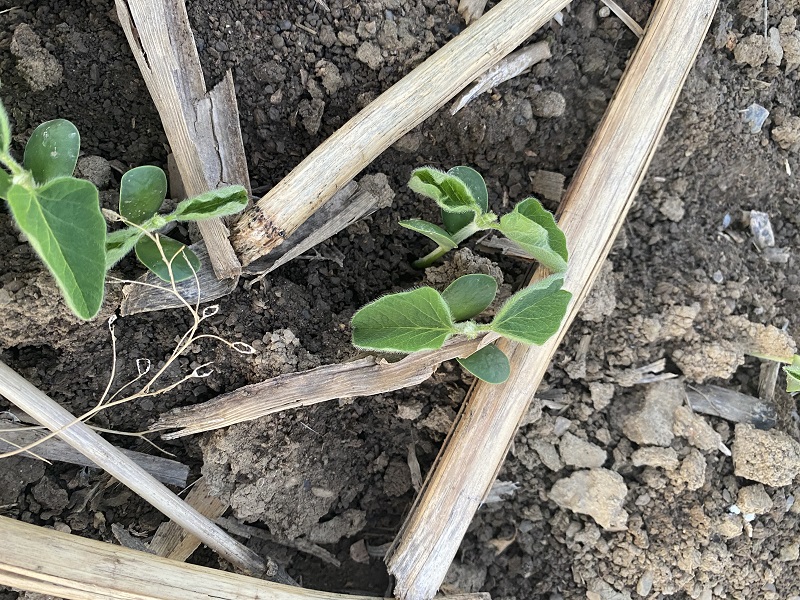
Numerous replant discussions and decisions have occurred over the past week, with stands just below where comfortable. Some fields were planted before the rains; others were waiting until after the rain to plant into moisture. The cause of replant could be due to planting too deep, sidewall compaction, moisture issues, very cold conditions after planting, slug damage, seedling vigour and more.
Be sure to get out and scout your fields, weeds are certainly emerging, and it is critical to ensure that the pre-emerge herbicides have worked and, if not, take steps to manage weeds. Remember, the critical weed-free period in soybeans is V1 to V3 stage (1st to 3rd trifoliate); in corn, it is V1 to V6 (one to six leaf collars).
It is that time of year when soybean aphids begin to show up. Be on the lookout for them in early planted fields. For more on what to look for this early in the season, vist Field Crop News. The aphid advisor app is a great resource that Grain Farmers of Ontario helped support through research.
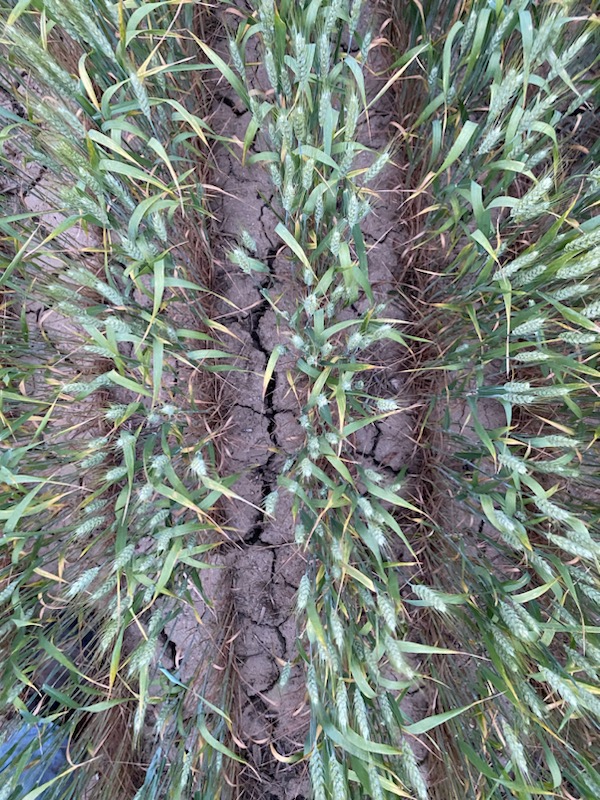
Cereals
Winter wheat has certainly taken the brunt of the moisture and heat stress over the past few weeks as it was heading out and pollinating. There are already reports of seeing where heads have aborted spikelets. Most winter wheat across the province is now at GS 59 (heading) and beyond up to GS 71 (milk stage), where kernels are beginning to accumulate starch and protein. Moisture is still a valuable commodity at this stage.
Spring cereals are growing well and in the tillering to elongation stage. Winter barley was pollinating through the warm, dry conditions causing yields to be impacted.
June 8, 2023
Another dry week has caused issues across the province, with crops needing a good rain. Hazy, smoke-filled skies have covered lots of the province due to fires located east and north; this will affect the solar radiation reaching crops and can slow development, as we have seen in past years.
Corn
Corn is off and growing (V2-V4, 3-6 leaf stage), although having a tougher start to the season than some years with cool weather, followed by dry with no rain in sight, for much of the province. Fields planted into less-than-ideal conditions, and even those planted into ideal conditions, are certainly suffering from damaged root systems and low moisture in general.
Currently, corn is undergoing a crucial stage; up until now, corn has been developing the seminal roots, and now it is time for the nodal roots to establish, roughly around V2 to V6 (2 to 6 leaf collars visible). Around V2, the first set of nodal roots should be visible; as each new leaf collar emerges, so will a set of nodal roots. Seedlings use nutrition from the seed reserves up until the V3 stage, when they begin gathering nutrition from the nodal roots. If the nodal roots are damaged or stressed, it can delay the corn’s development due to the plant needing to rely on seed reserves as opposed to taking up nutrients through the nodal roots. Things that might cause stress to the young corn plant’s nodal root development are salt injury from fertilizer, herbicide injury, seedling disease, insect feeding, compaction, and very wet or dry soils. Nodal roots will tap into the starter fertilizer band and use that nutrition for optimum development.
Rootless corn syndrome is an issue that might be showing up in fields that have limited moisture in topsoil, shallowly planted seeds, and/or dry seed furrow conditions. Poor nodal root development is the key indicator of this syndrome, causing lodged plants or plants that are about to lodge. If nodal roots do not get moisture when developing, development can stop, and in severe cases, the nodal roots can die. Corn impacted, if it doesn’t die, can recover if rains do arrive, as rain can re-promote nodal root development.
Some farmers might notice some purpling of corn plants in fields at this time. As with most things, there is an environment by genetic interaction, meaning some corn hybrid genetics will show more purple than others. This is due to the genes in some corn hybrids for producing anthocyanin pigments. Under early season stress conditions and poor root growth, like our recent hot/dry days, the plant builds and expresses the purple (anthocyanin) pigments. Corn usually will grow out of the purple state if it has enough available soil phosphate once the weather warms up and growth resumes. Typically, no yield loss will be seen if nutrients have been applied at proper levels. Purple corn can also be caused by phosphorus (P) deficiencies from restricted root growth due to soil compaction like sidewall compaction in the seed trench from planting in wetter soils or from a lack of moisture from dry soils.
Potassium (K) deficiencies may also appear as corn plants get stressed from heat and dry soil conditions. K deficiencies show up as a yellowing to necrosis of the outer leaf margins, which begin at the leaf tip and progress down the margin toward the base of the leaf.
Side dressing of corn is occurring.

Soybeans
Soybeans are also struggling with dry conditions. Some are seeing emergence issues with dry soil, and some replanting is occurring where it is very dry, with soils getting harder for plants to push through the surface. Soybeans are staging from VC (cotyledons) to V2 (2nd trifoliate).
For soybeans that are planted and actively growing, this dry weather is not the worst, as it encourages root growth while searching for moisture. It also promotes a lower chance of root disease and rots.
Be sure to scout crops to look for weed escapes. There has been some residual pullback in areas that received some rain, but not all weeds and not all herbicide programs have experienced this, so keep scouting.
As post emerge applications of herbicides occur, it is imperative to be aware of drift. Be aware of droplet size, distance to target, travel speed, wind, temperature, and other weather conditions. Always be sure to read and follow the label. Read more about drift mitigation in the Ontario Grain Farmer magazine.
Cereals
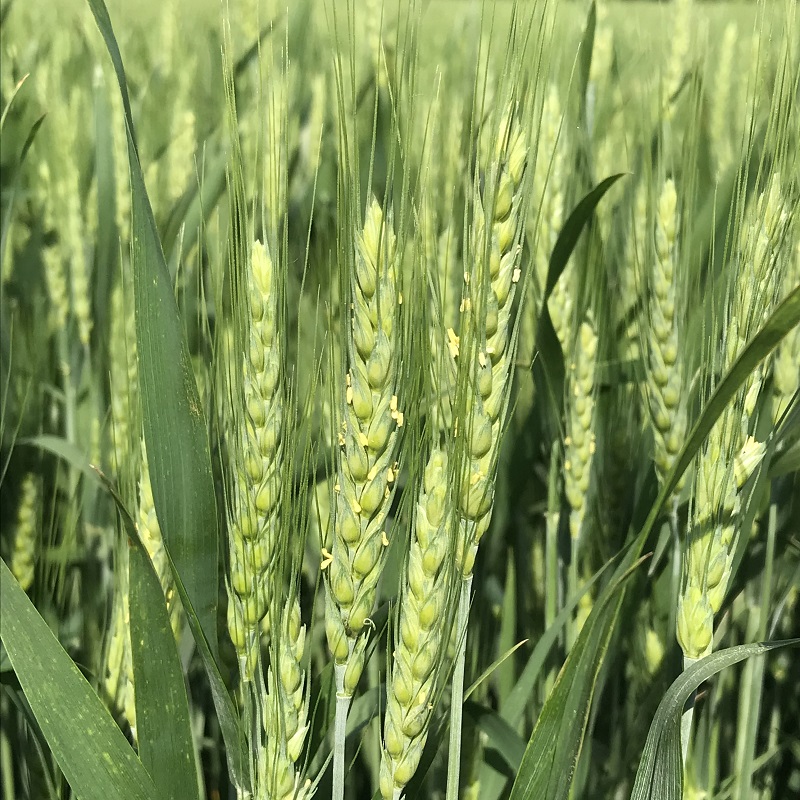
Winter wheat in the southern portion of the province is GS 57 to 69 (heading to flowering complete at the base of the head). Flowering begins slightly above the middle portion of the head and continues to the top, then continues down the remainder of the head. A reminder that if T3 fungicides are being sprayed that wheat heads are very sensitive to tank contamination – be sure sprayers are completely cleaned out. A general rule is six weeks after pollination, combines will start rolling for wheat harvest (it truly is amazing how fast the season progresses).
Overall, wheat needs a good rain as well. The high heat last week may have impacted pollination. See last week’s notes to read more about high heat during pollination.
Spring cereals also need moisture but are progressing well toward tillering.
June 1, 2023
A warm, windy week has resulted in ground drying out quickly (too quickly for some), with some serious concerns about crop emergence on heavier ground. Winter wheat is approaching anthesis for some areas of the province.
Corn
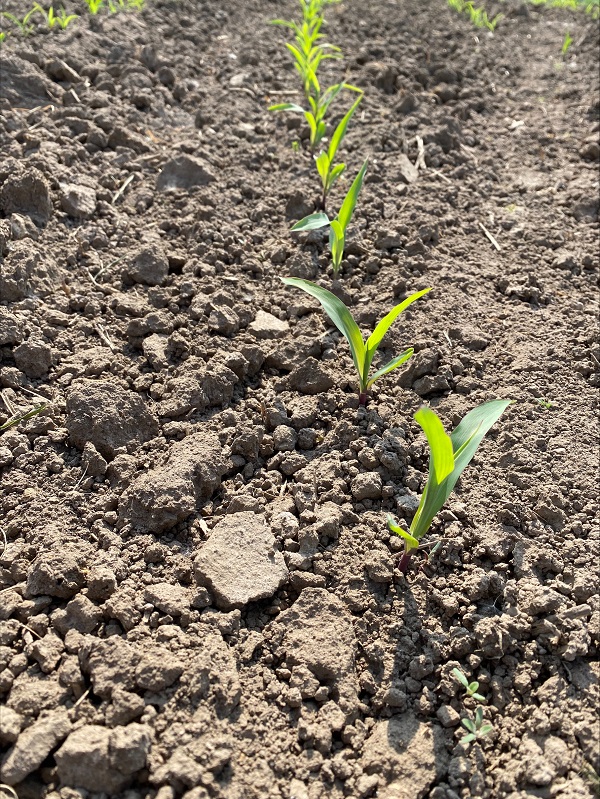
Corn planting is 95 to 99 per cent complete. The remaining acres are those waiting on rain or those that might be going in after a forage crop is harvested.
Fields planted earlier this month and that have emerged are staging around the VE (emergence) to V3 (plant with three leaf collars), also called the 4-5 leaf stage (if counting tips). Those acres planted on heavy clay and then received heavy rain a couple of weeks ago are seeing some significant crusting concerns, enough that the corn will not be able to emerge. Another timely rain is critical for these acres, and most of the province would be happy if another rain were in the near forecast.
Some April/mid-May planted corn had a number of days without any heat accumulation and was paused in early-mid May until the heat returned. This pause allowed time for cell damage to occur if conditions worsened, such as heavy rains firming the soil and the chilling effect weakening the vigour of the germinating seed, causing slow and strenuous emergence.
Those side-dressing nitrogen (N) are getting ready to apply their side-dress if little to no starter N was used. As the crop is growing quickly, keeping the plant from having a N deficiency too early in the season is critical. The growing point of the corn will be emerging at V4 to V5, so 164 to 246 growing degree days (GDD), which will be eight to 10 days away.
Soybeans
Soybean planting is still occurring but very close to wrapping up (80 to 90 per cent complete). Acres still to go in would be those on heavier ground or those who have numerous acres and are working away, or in some cases, those acres that are getting replanted from heavy frosts last week.
If still planting soybeans, planting at 2 inches should be no problem if able to get down to moisture; even up to 2.25” is fine with nice, warm temperatures that have been experienced. Any deeper, soybeans struggle to push the cotyledons through the soil as the hypocotyl of the soybean is only built to go so far. If the planter setting has too much pressure on the press wheels, the over-packing at deeper seeding depths can also cause beans to struggle to emerge, making the soil denser and the seed has to push harder. Ensure the planter is firming soil to the seed, not packing the seed into a vault. Two questions to ask before planting are: is the soil prone to crusting? And does the variety have enough energy to push up to the surface when looking at planting around 2.25” or deeper? If the moisture level is deeper than 2.25”, then two options are available:
- plant shallower (i.e., 1-1.5”) and hope for rain to provide moisture for germination,
- wait until it rains, and then plant into moisture.
It will depend on the soil and the risk level for crusting. Seed planted into warm moist soil will emerge quickly and stress-free.
Soybeans planted on heavier ground, combined with the cold nights and limited moisture, are struggling with vigour and cold injury. Warm weather and some light rain would go a long way in helping these fields emerge.
There has been some concern about applying residual products that need rain to be activated. In some cases, once the rain does arrive, there may be some reach back– but this would only be true for weeds up to roughly the 2-leaf stage. With this warm, dry weather, some weeds are hardening off, which can create difficulties for herbicides to manage weeds such as lambs quarters etc. Winds have been impacting spray timing. Be sure to follow label recommendations for wind speeds when applying.
This year, many herbicide trait options are in the field: Roundup Ready, X-tend, Enlist, and Liberty. Please be sure to apply the correct herbicide to the correct fields and ensure you ask your neighbour what trait they have instead of assuming everyone has the same as you. Try to avoid any disasters for yourself or your neighbours.
Soybeans should begin nodulating two to three weeks after emergence, and it is always a good idea to see how nodulation is going. In first-time soybean fields, nodules will be found on the tap root; in fields that have had soybeans before, the nodules will be on the lateral roots.
Cereals
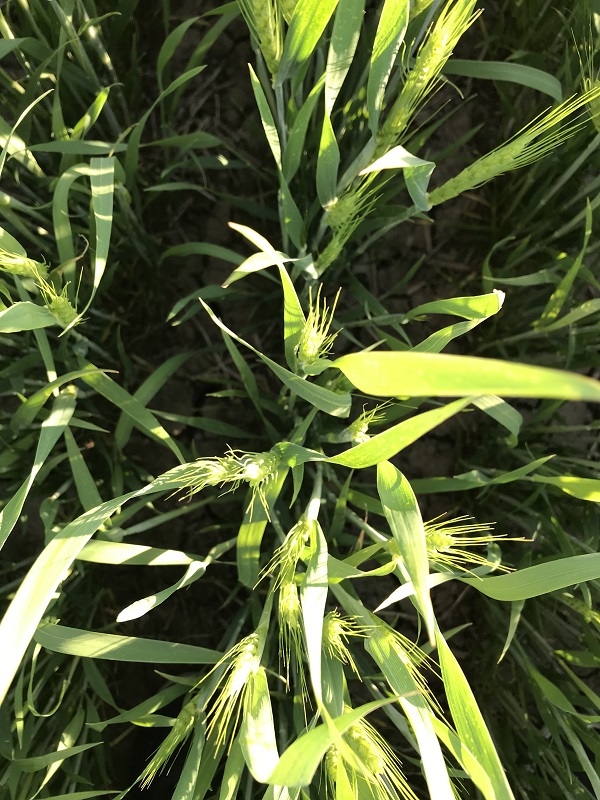
Overall, winter wheat looks spectacular across the province and is staging anywhere between flag leaf (GS 39), and head emerged (GS57). Septoria and powdery mildew are still present and are being found to be increasing pressure. While moving up the crop canopy, a spray application of a fungicide might still be warranted to protect the flag leaf in some fields.
Wheat that is heading out or will be shortly, keep an eye on it as with the current heat wave this week, it has been progressing quickly. It is important not to miss optimum timing if applying a T3 fungicide.
The main indicator for T3 timing is when 75 per cent of heads on the main stem have emerged (GS 59). This is Day 0, and the optimum timing is Day 2. This is the beginning of pollination when anthers are visible on the middle of the wheat head. A good reminder, make sure the sprayer is well cleaned out, as wheat is very sensitive at the flowering stage.
If no rain occurs during anthesis and early grain fill, the chance of DON is low. With no rain during grain fill, kernel grain fill will also be limited. Ideal conditions for fusarium development are precipitation or high humidity for at least 12 hours for spore germination and infection. Temperatures favouring infection range from 16° C to 30° C, with the optimum range for F. graminearum being 25° C to 28° C. Even with a low DON risk, applying a fungicide at this time is still beneficial to increase plant health and stay green, especially if stressed.
With wheat heading out and flowering in some areas with temperatures in the high 20s, there is a concern for heat stress. Wheat is sensitive through most of its life cycle to high temperatures. One stage that is most sensitive, though, is anthesis (flowering). The longer the temperatures last and the higher the temperatures are during this stage, the more serious the yield loss potential. Temperatures above 27.5 C immediately before anthesis can severely reduce pollen viability. Any sort of drought stress as well during this time can further impact pollination.
Spring cereals can be staged at GS 13-17 (3 to 7 leaves) and, like the above crops, could use some moisture.
May 24, 2023
There will be an incredible number of acres in the ground by the last week of May, all planted within a very short window. Will it be a record? The week ahead looks ideal for completing #plant23 across much of the province.
Corn
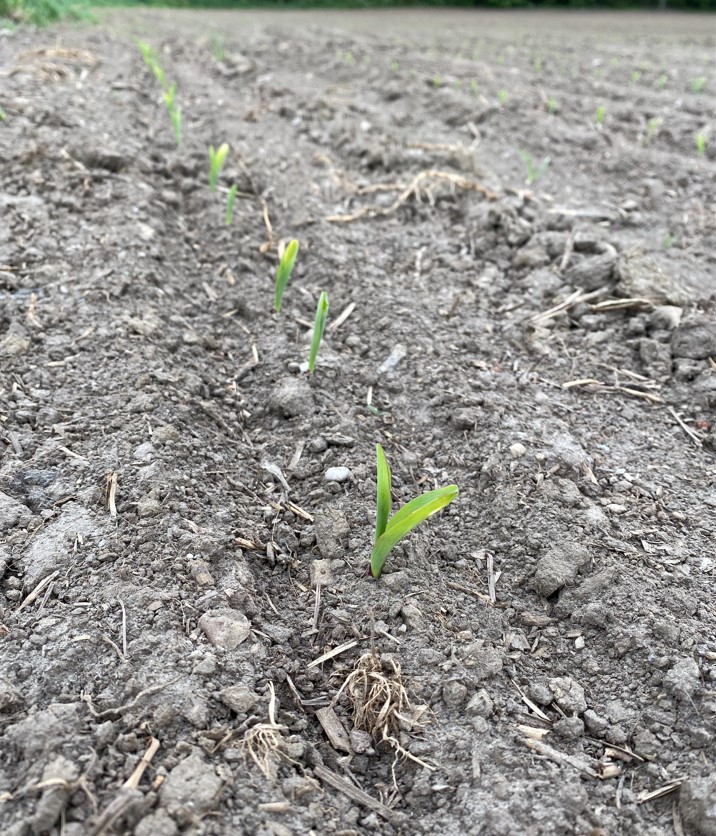
Most farmers across the province got to catch up on a couple hoMost farmers across the province got to catch up on a few hours of sleep on the Victoria Day long weekend. A timely rain, bringing anywhere from 0.1” to over 2” across the province, created the perfect rain delay. Up to 80 to 99 per cent complete for corn planting across the province. Most of the corn that is in the ground has germinated or will be shortly with the warm temperatures being experienced. On the heavier clays, there was found to be some crusting, which could cause emergence issues, but the rain this past weekend should help mitigate those issues.
One thing to keep in mind as the corn does emerge is how uniformly it is emerging. If corn was planted this past week, with maximum corn heat unit (CHU) accumulation (30 per day), the corn could be out of the ground in five to six days, which is a lot less time for insects to be active, as well the soil temperatures would move them down in the soil profile (a huge plus for planting into warm soils). Overall, with the cold nights this year, emergence might take a bit longer, with some emerging around nine days. It is not time that gets the crop out of the ground; the heat drives the enzymatic process to get the seed to germinate, and the continued heat helps the cell growth of the developing plant seedling. Pay attention if there is even emergence or not, watching individual rows for differences as well. As the season progresses, pay particular attention. See if the later emerged plants are weaker and smaller. Did they pollinate later? How was the ear size or cob fill? Does emergence timing make a difference in your crop?
With the recent rain, pre-emergent-applied herbicides should have activated. Most herbicides do not claim to have reach-back activity. However, there should be activity on weeds that are germinating. Pay attention to weeds that have gotten past the herbicide due to weed emergence before rains, and come back in and clean up if necessary.

Soybeans
Up to 85 per cent complete on soybean planting, and after a short rain delay over the weekend, many were moving again mid-week to move the planting progress needle even closer to the finish line.
Soybeans that have been in the ground since last week will emerge shortly. Soybeans are more prone to poor stand establishment than other crops as they need to pull their cotyledons up and through the soil. Once the field has emerged, it is always a good idea to check on emerged plant numbers.
Cereals
With the warm weather, winter wheat is progressing quickly. Wheat is at boot stage in southern Ontario (GS45-49), while in other parts of the province, wheat has the flag leaf emerging (GS 37). In Northern Ontario, the growth stage is in stem elongation (roughly GS32-33). In the deep southwest, wheat will be heading out soon, with farmers getting ready to spray for Fusarium. Wheat fields that are most susceptible to Fusarium infections are those planted after corn or susceptible varieties. Once 75 per cent of the heads are completely emerged on the main stem (GS59), ideal fungicide timing is approaching. The optimum timing is at the beginning of pollination (GS61) when anthers are visible on the middle of the wheat head. Timing is critical, and the crop will be moving very quickly through stages with all this heat. Be sure that your sprayer has been cleaned out well before fungicide applications.
Overall, leaf dOverall, leaf disease pressure is still low in the field. Fields should still be monitored, though, especially susceptible varieties.
A wide range of sulphur (S) deficiencies have been identified in this year’s winter wheat crop, even on fields with S applied. S is a mobile nutrient, and with the wet/cooler weather in the early spring, the S could have moved deep within the soil profile, and the cooler weather could have impacted root growth to reach the mineral. S deficiency can often be seen as patches of yellow plants within the field or areas that are stunted, thin or with delayed maturity. S plays a crucial role in photosynthesis and the production of chlorophyll. If a deficiency is seen or found through tissue sampling, it can be corrected. The sooner the mitigation is taken, the better.
Physiological fleck is also showing up in some fields, caused by prolonged cloudy days. More info is available in this Field Crop News article.
So far, pest pressure is low this year. A common pest to the region is armyworm, which commonly shows up with thunderstorms coming from the south; no major storms from the south lowers the incidence of their arrival. Cereal leaf beetle numbers also, at this point, have been low.
Looking at winter barley, it is currently heading out with low injury from last week’s frost. Be on the lookout for Barley yellow dwarf virus. More information can be found on the Crop Protection Network website.
Spring cereals have emerged and are roughly at GS 11-13 (seedling growth). In some fields, there was frost damage from last week; however, nothing detrimental. •
May 17, 2023
A better week for planting could not have been asked for these past seven 7 days across most of the province. A lot of crops have gone into ideal or close to ideal conditions. However, it was not perfect for everyone, as regions of northern Ontario experienced some snow early this week.
Corn
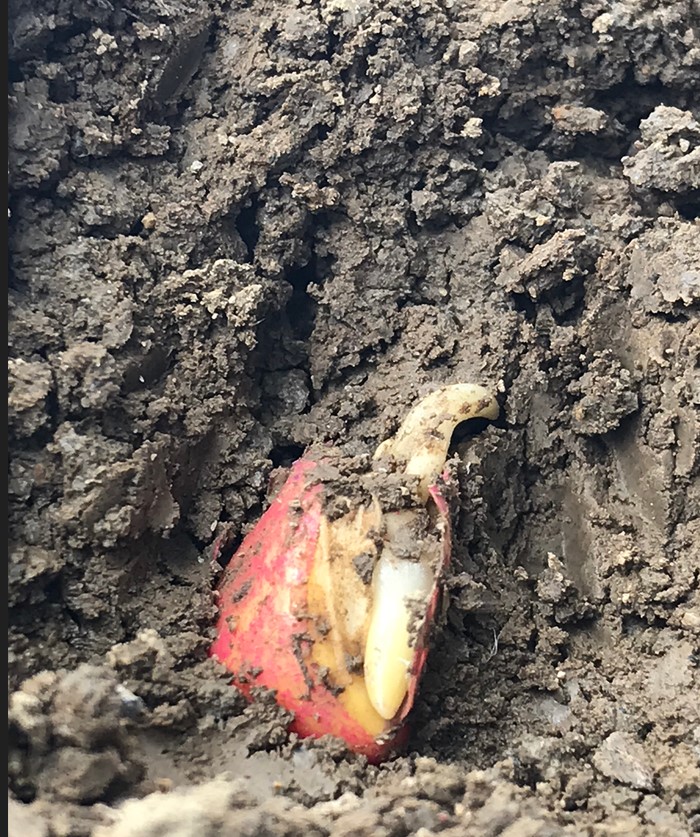
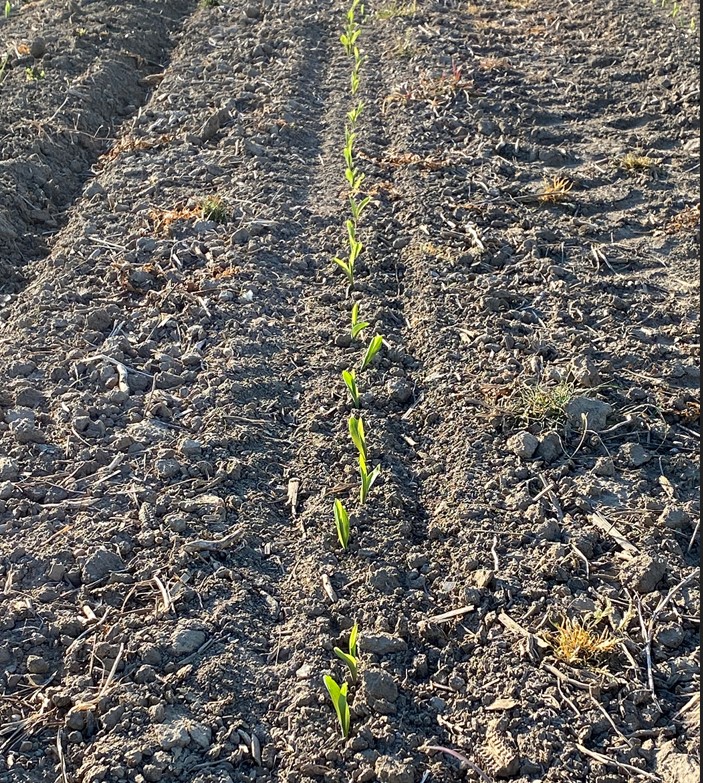
Seventy to 90 per cent of corn has been planted across the province. Soil conditions dried up very quickly, allowing many acres to get planted in a short window of time with no forced breaks.
There is a potential for uneven emergence due to variable moisture content and drying of the soil across fields. It will be clear to see seed that was planted into moisture and seed that was not. Overall, corn is slow to emerge with cool soil temperatures during planting and the days after. Some corn planted during the warm weather in mid-April has been seen to have crusted soil due to heavy rains after planting and then drying out. A rotary hoe might be needed in these situations to help free the emerging corn from the crust.
If you are still planting corn with dry conditions, remember to plant into moisture; a 2.5 to three-inch depth is ok if you need moisture. Also, something to keep in mind: do not fluff the soil but keep the seedbed firm to retain the moisture. Those who have run packers behind their cultivators might be wise this year to keep soil moisture in the soil.
Cooler temperatures/frost was seen across much of the province earlier in the week. With corn still not having emerged, there is little concern over the frost affecting the plant. And if the corn has emerged, the growing point is still below the soil surface.
Rain in the forecast for this weekend will be beneficial to crop management. If rain does not arrive, fields that have had a pre-emergent herbicide applied will need to be monitored for weed control in the coming weeks. Some pre-emerge herbicides do need rain to activate the herbicide. Scout and be prepared to take action if cleanup is needed. Managing weeds in the early stages of crop growth is crucial for yield; the same goes for soybeans. •
Soybeans
Like corn, soybeans acres have rocketed into the ground without delay. Acres planted are around 40 to 70 per cent in regions.
Soybeans planted in April that have emerged are at the VC (cotyledon) stage; with the cool weather that was experienced this week, there could be some frost damage on soybeans that emerged on lighter soils or muck soils as those soils hold less heat, during cool temperatures.
Wheat
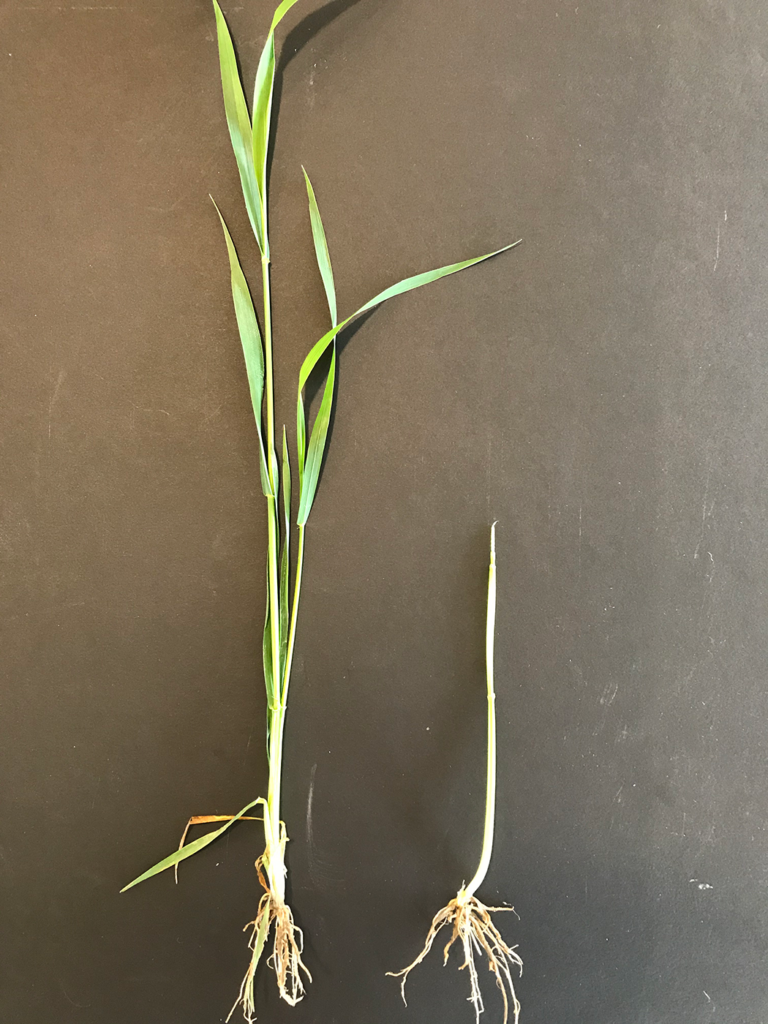
Winter wheat is staging up to GS 37 (flag leaf just visible), however the deep southwest might be seeing some wheat roughly at GS 41 (booting). If split applying nitrogen GS 32 to 39 is the optimum application window.
The flag leaf accounts for over 50 per cent of photosynthates used for yield. T2 fungicide applications have been occurring to keep the emerging flag leaf clean, where warranted, overall disease pressure has been low. However, be on the lookout for Powdery mildew and Septoria; disease infection is varietal specific. Take note of which varieties fare better than others. Fungicide applications should be decided based on the severity and presence of the two leaves immediately below the flag leaf. T3 timing (to protect the head) for some fields will be just around the corner.
With the cooler temperatures experienced earlier this week, there has been some concern about spraying. Be sure to read the label or speak with an agronomist if you are unsure if you should spray a certain product.
Similarly, with the cooler temperatures, give wheat a few days after the frost to scout and see if there is any damage. There might be some leaf tip burn but hopefully not much else. When wheat is in the boot stage (GS 41-49), there can be some injury if the temperature remains low for an extended period of time. Not to jinx anything, but the next full moon is on June 3. Let’s hope that it is cloudy for all crops’ sake. •
May 11, 2023
Sporadic rains across the province over the weekend delayed fieldwork in some regions, while other areas were full steam ahead at the beginning of the week. Areas that were still waiting for ideal soil conditions should get rolling shortly. Some may have noticed a haze in the sky due to wildfires in Alberta. This haze could slow the drying of fields slightly, as it impacts sunlight, but with promising forecasts, spring planting will soon be occurring widely across the province.
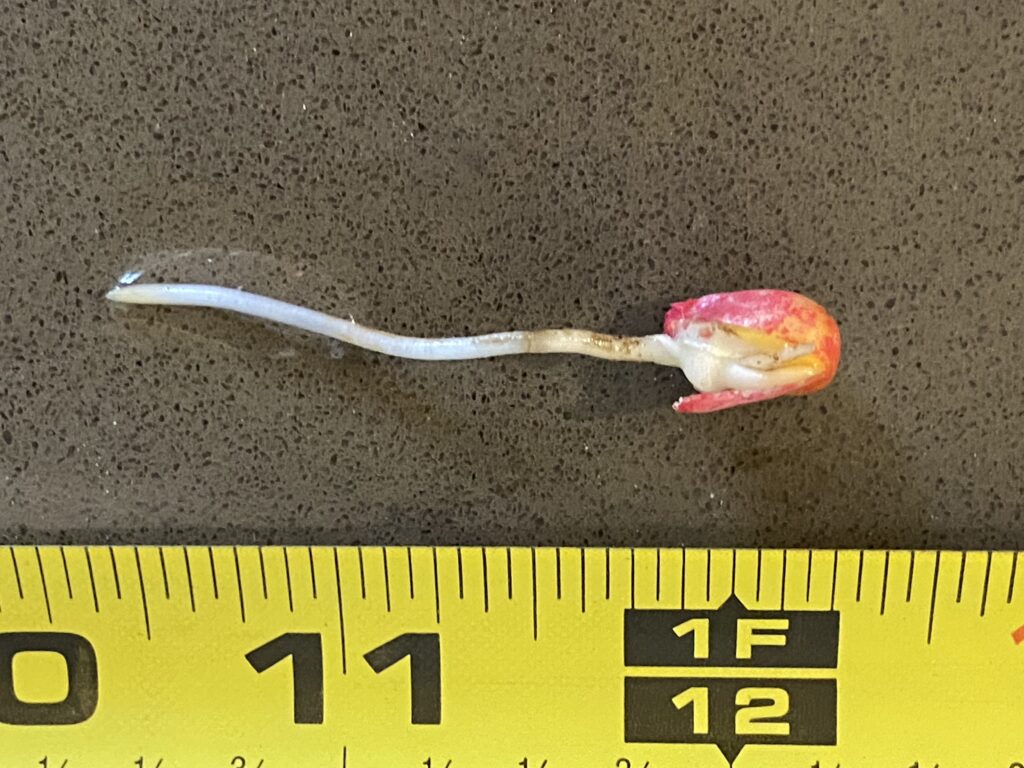
Corn
Areas of the province have finally dried up enough for further manure applications and tillage to start at the beginning of the week. Planting and any pre-plant/pre-emerge herbicide applications soon followed.
Soybeans
Soybean planting has begun this week as well. As the weather holds favourably over the remainder of the week, there will most likely be a number of acres planted.
The increase in daytime and nighttime temperatures will drive corn heat unit accumulation resulting in rapid plant growth (both weeds and crops). Burndown herbicide applications will now see faster-acting herbicidal activity as plants develop quicker as temperatures rise. Some weeds, such as winter annuals, have continued to grow during the past few cool weeks. Canada fleabane has already progressed and is ready to bolt with these warmer temperatures. Be timely with burndown applications, as bigger weeds are harder to control and may need additional measures for effective control.
As planting really ramps up, remember to take breaks. Working while tired leads to avoidable mistakes and accidents. Be sure to get home safely to your family every day.
Depending on which regions of northern Ontario fields are located determines field activity. Areas such as New Liskeard have dried up nicely with fieldwork and planting occurring; others, such as Cochrane, received heavy rains and will take another week or two to dry up. With the calendar date being where it is, much focus is on spring grains but will quickly change to silage corn and soybeans. Overall, the forecast is looking favourable.

Cereals
Winter wheat in Ontario is around the second node (GS31-32) up to flag leaf emergence (GS37, flag leaf just visible). Wheat has moved quite slowly this past month with the cooler temperatures.
Herbicide applications need to cease by flag leaf so as not to cause head injury. If spraying is done in cool conditions, many have focused on only using one product in the tank to prevent wheat injury. Second applications of nitrogen have been applied, especially where flag leaves are starting to emerge. Burn from a fungicide/herbicide application can impact yield, so use caution when applying in cold weather. Be sure to speak with your agronomist to determine which herbicides are easier on wheat if temperatures dip toward zero.
Some winter wheat fields have been or will be terminated in northern Ontario due to winter kill.
Keep an eye out for pests in fields; cereal leaf beetle can show up around this time in fields. The Pest Manager app is an excellent source of information on all pests. Grain Farmers of Ontario supports much of the research that is used in the app. It applies to pests, weeds, and disease and is updated regularly based on current research data.
May 4, 2023
It has been a slower week across the province, with heavy rains and/or snow this past weekend and into the start of the week, causing equipment to remain parked.
Corn
Any planted corn is slow to emerge due to cold temperatures. The radicle (first root to emerge from the seed) on some planted corn can be seen. Insect feeding damage may occur. Corn seed typically requires 165 to 175 CHU for emergence. Looking at accumulated CHUs for the Ridgetown area this year, there have been only 66 CHU since April 15, 2023.
Cereals
Cool weather has slowed the growth and development of winter wheat; the approximate staging for wheat is around the Growth Stage 31 – 35 (stem elongation). Information on how to identify which Zadocks stage wheat plants are at can be found in A Visual Guide to Winter wheat staging, pages 25-26 show in-depth pictures and descriptions of stem elongation at GS 31.
Many fields have now received a first pass of nitrogen. Those that are still waiting on the application might be showing N deficiencies (the oldest leaf will be paler than others, with yellowing beginning at the tip and moving downwards). Some wheat has been showing manganese deficiencies, predominantly in sandy and loamy soils. There have also been some Zinc deficiencies on clays and some sulphur deficiencies as well. Be sure to get out and scout so that corrective action can be taken if needed.
In northwestern Ontario, fields have dried up enough in some areas that spring cereals are getting seeded.
Weeds
It has still been a bit too cool and wet for many areas to begin spraying herbicides. Once annual weeds have further emerged, there will be herbicides sprayed as the weather cooperates. Winter annuals are growing quickly. Watch that they do not get to a stage where they are too large to control easily; adjust rates to get good control.
April 27, 2023
As the end of April creeps closer, cool weather, rain, and snow have hindered field operations. But never fear; there is lots of time left to get into the fields. A few good drying days can change a lot.
Corn and Soybeans
A very small amount of corn and soybeans went into the ground across Ontario during the unseasonably warm temperatures experienced in mid-April. Ground conditions were very good for these earlier planted crops; however, most farmers focused on spreading manure, fertilizer and getting nitrogen down on wheat. Showers and cool weather have slowed down fieldwork. Looking at the long-range forecast, there appears to be several rain showers headed for Ontario, but this can change.
It is important to note that it is still very early in the spring season. When planting corn and soybeans, it is great if they go into warm soil and the first moisture that is taken into the seed is also warm (relatively speaking – they don’t need 80-degree shower water like we do!) The first 48 hours after planting are critical to avoid cold/chilling injury. The first drink the crop gets should be warm. Cold water taken into the seed the cells do not allow the cell the same elasticity as if it had warmer water. Depending on the conditions and the crop, different cell damage can occur, causing damage to the new sprouts and resulting in poor and uneven emergence that will affect plant stands and, ultimately, yield.
True armyworm and black cutworm have been caught in traps. Other pests are also becoming active with the warmer weather. Good soil temps help plants emerge quickly, with less chance of insect feeding on seeds.
Above all things, planting into fit soil, with both temperature and moisture taken into consideration, is crucial for good emergence.
Cereals
Similarly to the above crops, some spring cereals also went into the ground in mid-April.
With the above-average warmth, winter wheat really took off. Farmers took advantage of the beautiful weather to apply the first pass of nitrogen (N) on the wheat crop. Overall, wheat crops look very good, especially those that have had a first shot of N, especially if the N was applied during the warm conditions. There are, however, some poor stand areas within fields where water has laid during the spring melt.
Cooler weather this past week has slowed down growth stage progression allowing a bit more time to get everything applied in a timely manner. Fields are staging around the Growth Stage (GS) 30-31, the beginning of stem elongation and the first node (GS31), the stage where the Yield Enhancement Network participants are getting their first tissue sample for analysis. As temperatures increase, be on the lookout for leaf disease within the next week or two. With dense canopies, stem elongation is an important time for T1 fungicide timing (if pressure and disease timing are sufficient), weed control and N applications. It is also the start of the optimum window for most plant growth regulator (PGR) applications. Read more about what PGRs are available on the market and optimum timings in this Ontario Grain Farmer article on PGRs. It is a good idea to keep in mind that GS 32-39 is the recommended window for a second pass of N. Herbicide applications will also be approaching. Remember to avoid temperatures below 5 degrees Celsius the day before and after spraying.
Have a great spring. When things do get rolling, remember to take breaks and stay safe.
April 13, 2023
Wheat
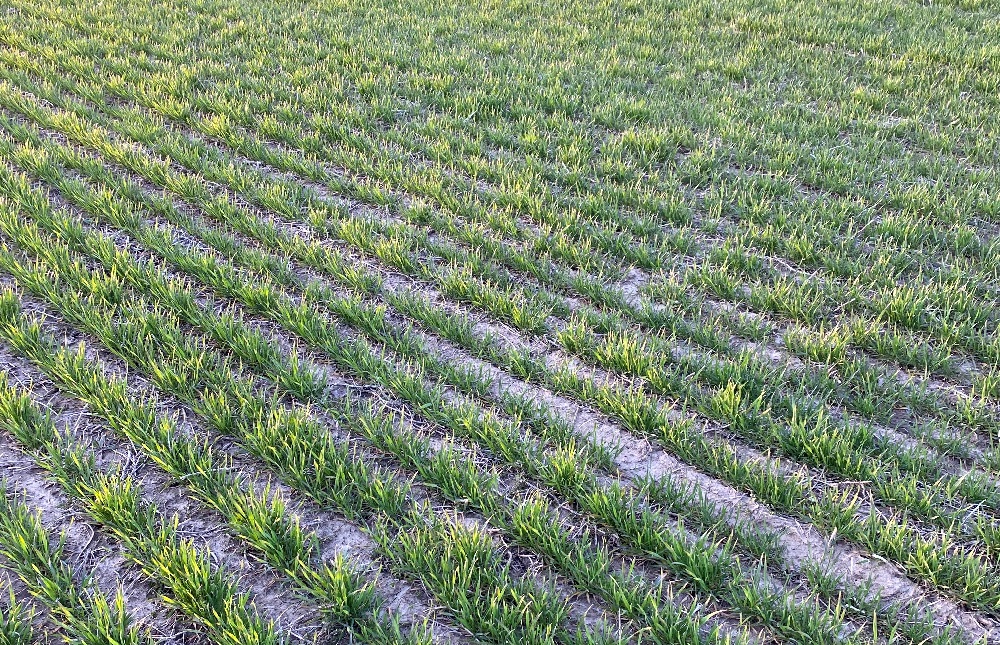
Winter wheat has come through the winter looking great across much of the province. There are a few yellow spots where water laid a little too long last week with the 3-inch rain. Many fields are staging around four to six tillers (GS 24 to 26). With good populations and potential thick stands, if you are managing for higher yields and have experienced lodging in the past, a plant growth regulator (PGR) application during stem elongation might be something to consider for those intensely managed acres. Split nitrogen applications can also help in managing later lodging concerns.
If a winter wheat field is not looking as good as it should, as fields green up, it is a great chance to assess survival. Read more in this Field Crop News article: Assessing winter wheat stands for winter survival.
Along with the warm and dryer weather, early nitrogen applications will be going down across fields this week. Optimum nitrogen (N) rates and timing are key to producing top-yielding wheat. The question of split applied N is a common one most years. More information on split applying N can be found in this Field Crop News Article: Should I split apply nitrogen in winter wheat?
























